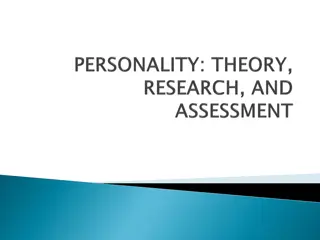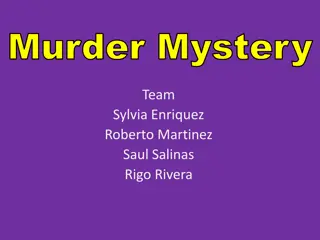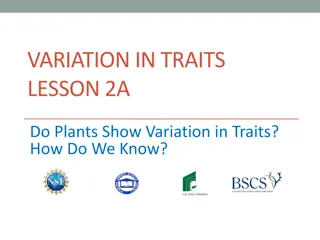Understanding Serial Killers: Motives, Methods, and Traits
Delve into the chilling world of serial killers, where repetitive homicides unfold with grim precision. Explore the motivations that drive these individuals, from sexual impulses to the quest for power. Unravel the distinct patterns in their behavior, from modus operandi to signature traits that set them apart. Discover the eerie characteristics shared by many serial killers, such as intelligence, charm, and a chilling lack of conscience.
Download Presentation

Please find below an Image/Link to download the presentation.
The content on the website is provided AS IS for your information and personal use only. It may not be sold, licensed, or shared on other websites without obtaining consent from the author. Download presentation by click this link. If you encounter any issues during the download, it is possible that the publisher has removed the file from their server.
E N D
Presentation Transcript
Serial murders - repetitive homicides, nearly always one-on-one murders, where the perpetrator is usually a stranger or has a slight acquaintance to the victim.
Serial Murders The serial murderer s motivation to kill is not based on crimes of passion, victim precipitation, personal gain or profit. Serial murderers are nearly always males prompted by sexual or aggressive drives to exert power through killing.
Modus Operandi Object - kind of property taken, such as bras and panties Time - time of day or night, weekdays, non-work days, holidays (when people would not miss the perpetrator at work) Style - the description the criminal gives the victim to gain entrance (plumber, cable TV repairman) Tale - any disclosure the criminal makes as to his business/purpose Pals - any co-conspirators Transport - what type of vehicle was used in connection with the crime Trademark - any unusual act committed by the suspect while in the commission of the crime (i.e. poisoning the cat, eating at the scene after murdering the grandmother)
Signature - the murderer's psychological calling card, unusual characteristics of a murder that are repeated at several crime scenes: Intentionally displaying victims in a spread-eagle position. This behavior reinforces the perpetrators underlying psychological needs.
Difference Between Modus Operandi and Signature Two murderers both burn their victims by dousing them with gasoline. The second murderer douses the victim with gasoline to cover up the crime. This murderer does so to evade detection. This therefore is a precautionary act, and as such is a modus operandi behavior. The first murderer does so as an anger-retaliatory act. This is a signature behavior.
Characteristics of Serial Killers Usually intelligent Good appearance Superficial charm Able to differentiate right from wrong Have no conscience Enjoy victim's terror Ted Bundy
Serial Killing Versus Mass Murder Charles Whitman, the man who shot multiple people from the tower at the University of Texas, was a mass murderer, not a serial killer Dylan Klebold and Eric Harris, the shooters responsible for killing 12 classmates and a teacher in the deadliest school shooting in U.S. history, are also classified as mass murderers, not serial killers
Organized Serial Killers Perpetrator plans the murder for months or years beforehand. Offender is normally married, has steady employment, and is thought to be a good member of society (ex., BTK- Dennis Rader) They bring the instruments of the crime (knives, guns, tape) to the scene with them. When Ted Bundy was pulled over for driving suspiciously (in 1975), police found an ice pick, ski mask, rope and handcuffs in his trunk. These murderers are often highly intelligent and are knowledgeable about forensic evidence and law enforcement's investigative capabilities.
Disorganized Serial Killers They do not plan their crimes in advance. The disorganized murderer commits the crimes spontaneously. They are often unemployed and without transportation. They are more often of low intelligence or psychotic.
Psychological Types of Serial Killers Power Oriented Ted Bundy and Dennis Rader enjoyed watching terror of their victims Mission Oriented - killers feel they are improving the world by getting rid of undesirable people such as prostitutes, i.e. Green River Killer Gary Ridgway Visionary - those who kill because they are directed by hallucinations, i.e. David Berkowitz - "Son of Sam"
Psychological Types of Serial Killers Hedonistic - gain sexual satisfaction from raping, killing, mutilating, and sometimes eating the victim, i.e. Jeffrey Dahmer Comfort - those who kill for financial gain, such as insurance benefits, real estate, i.e. Golay & Rutterschmidt Disciple - those killers who kill under the influence of a charismatic killer, i.e. Leslie Van Houten and Lynette Fromme of the Manson family
Psychological Profiles of Serial Killers A psychological profile is a submitted report utilizing information and approaches from various social and behavioral sciences, focusing on a specific type of violent crime According to the FBI, a typical serial killer is a Caucasian male between the ages of 18-32 who has been a victim of child abuse and who has exhibited signs of the McDonald triad McDonald triad bedwetting after the age of 12, setting fires, killing small animals
Psychological Profiles of Serial Killers McDonald Triad Most serial killers exhibit at least one of these behaviors According to Robert Ressler (FBI), more than 60% of serial killers wet the bed past the age of twelve The Son of Sam, David Berkowitz, set 1,412 fires but switched over to killing because it gave him more excitement and TV news coverage Keith Jesperson, a serial killer from British Columbia who murdered more than 160 victims, started with dozens of cats and other small animals, before he moved on to human beings

























